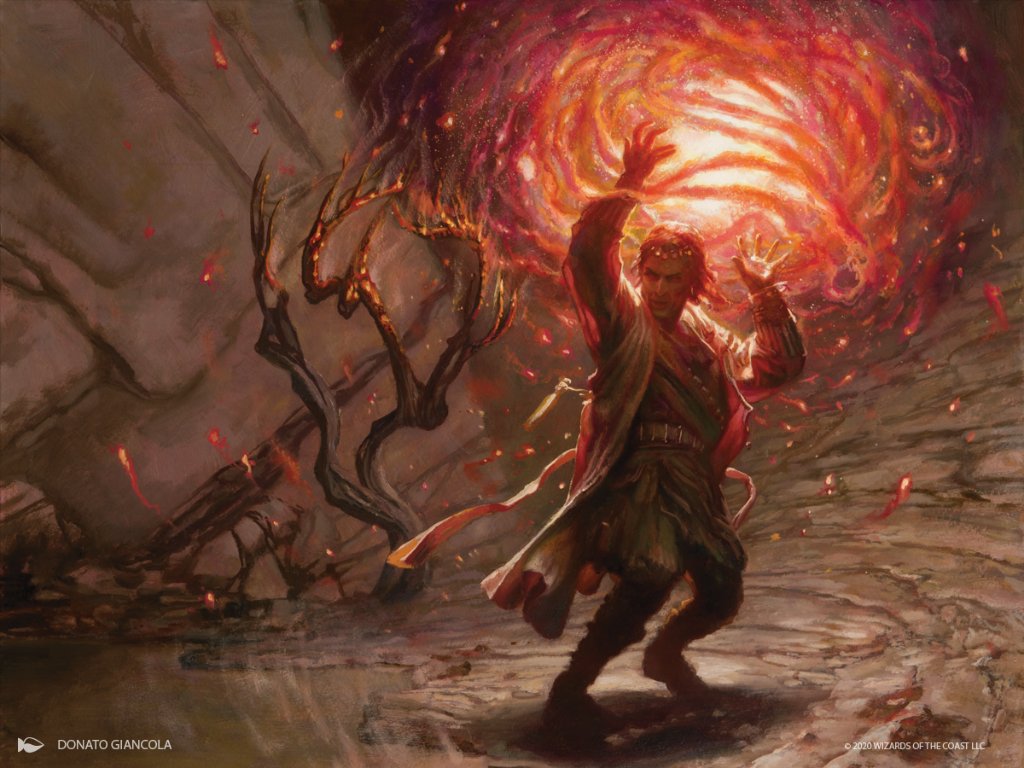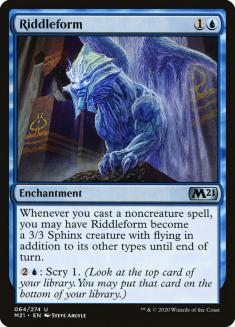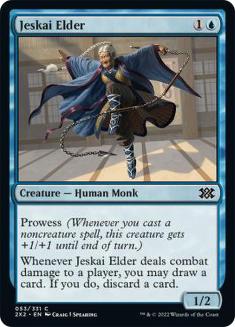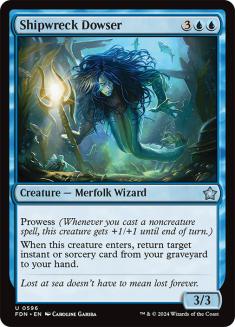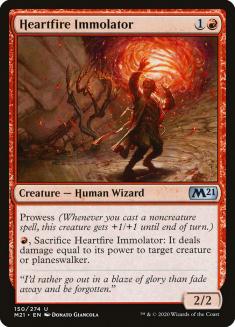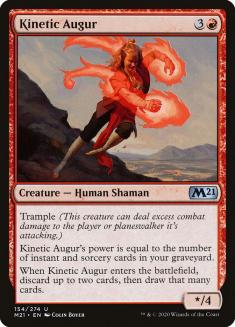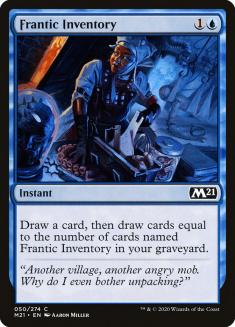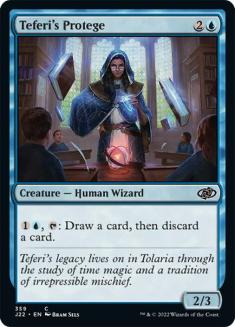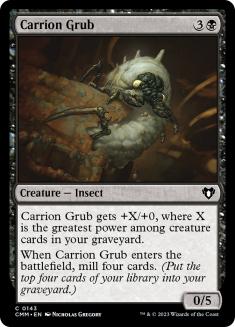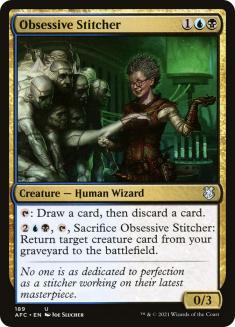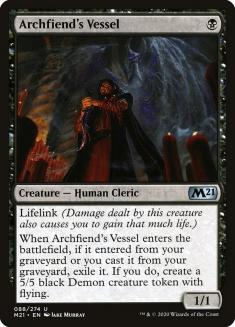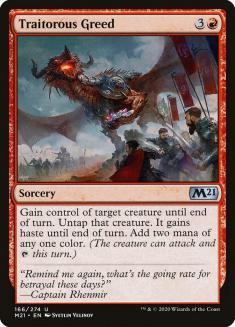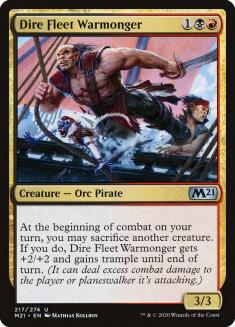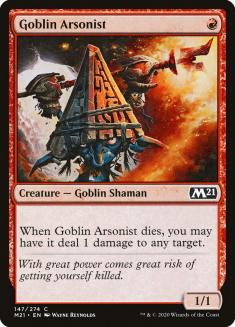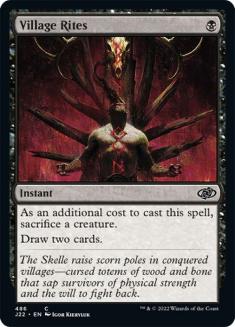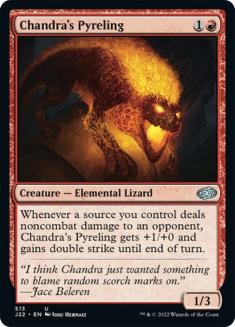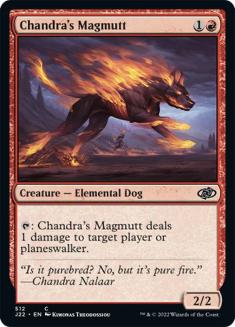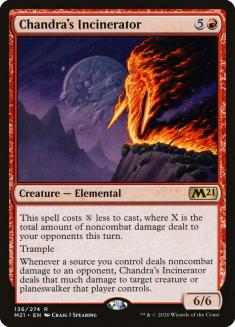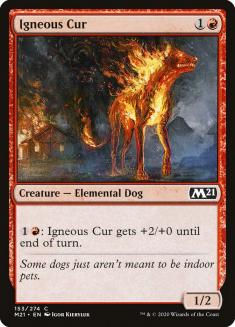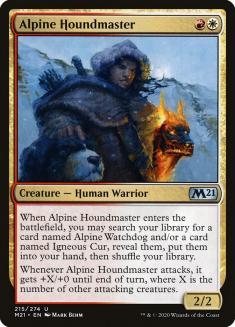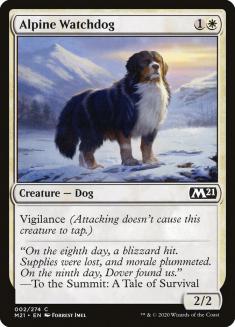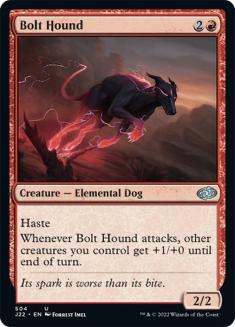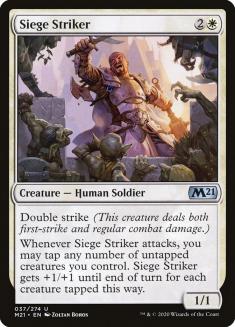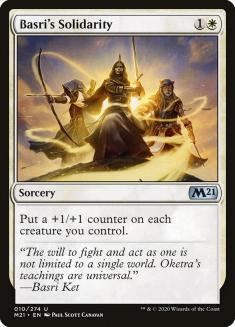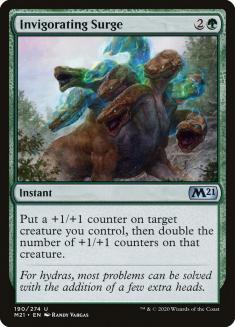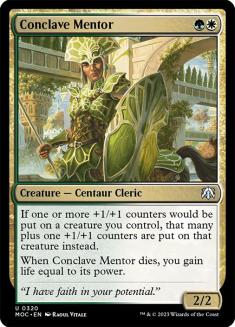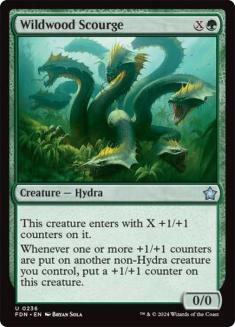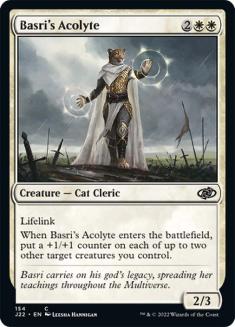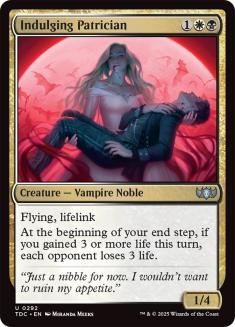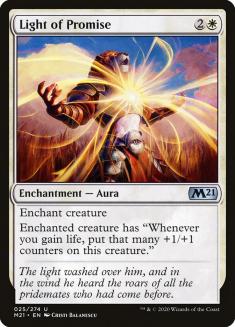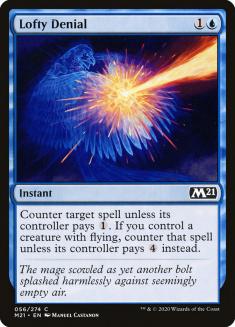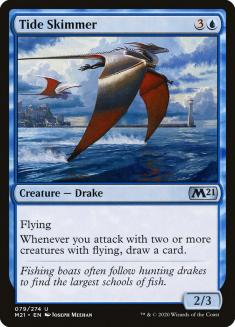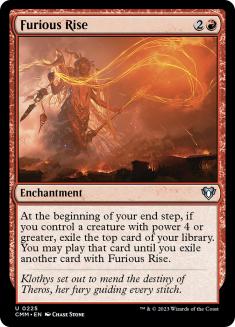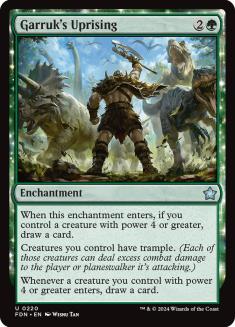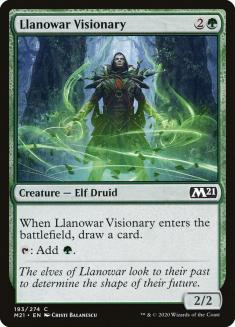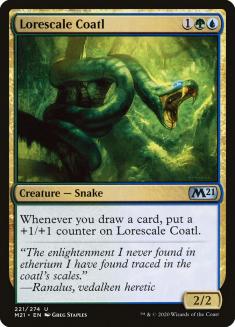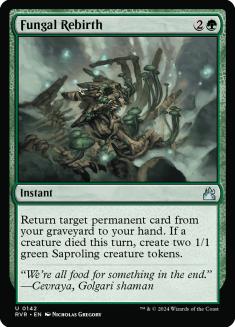Limited decks are built on a basis of commons. Unfortunately, commons are the last cards previewed for any new set. However, that doesn’t mean it’s impossible to think about Limited until all of the commons are known. Many uncommons provide a strong signal to both macro- and micro-archetypes. Let’s take a look at what the new core set has to offer:
Izzet is almost always a spells-matter archetype. Prowess is an evergreen mechanic that is often present, and variants of it, such as Sprite Dragon, are also familiar. But the first glimpse into the Izzet spells deck for the new set is a bit different. Kinetic Augur suggests that this archetype will care about the graveyard.
We have seen this style of Izzet deck many times, and it usually exists to tie together cross-archetype graveyard synergies. Shadows over Innistrad supported a Rise from the Tides deck, with Pieces of the Puzzle as a key common. Guilds of Ravnica had jump-start as a mechanic that cared about the graveyard, as well as wonderful interaction with the surveil mechanic. Given that Jeskai Elder and Shipwreck Dowser also interact well with the graveyard, I believe we will see Izzet use it as a resource.
Frantic Inventory and Teferi’s Protege also suggest that blue will care about the graveyard for at least a few archetypes. While Teferi’s Protege is unassuming, that actually provides more information rather than less. Blue looters are typical at common. Recently we have seen Facet Reader and Erratic Visionary. Neither card was great, but I believe both are better than Teferi’s Protege in a vacuum. It’s possible that, with all the graveyard themes in blue, a two-mana version of this effect was too powerful at common, so they bumped it up to three mana and gave it a better body. The card will probably see play, especially if Dimir plays as it currently looks, but it is unlikely to be a key common.
My speculation on Izzet is further cemented by the graveyard prevalence in Dimir. Often, a subset of archetypes that share colors will have interwoven synergies designed to make pivoting easy. If I’m drafting a Dimir self-mill deck and red is open rather than black, it is likely that my blue cards will pair very well with that late Kinetic Augur.
With Obsessive Stitcher as the key uncommon for Dimir, I wonder if reanimation will be a frequent occurrence. Dimir could simply be an archetype that deeply cares for the graveyard rather than a dedicated Reanimator deck. It’s quite hard to support Reanimator in retail Limited, as the payoffs cannot generally be printed at common. Archfiend’s Vessel does suggest, however, that there will be a noticeable amount of ways to bring cards out of the graveyard.
Surprise, surprise, Rakdos is a sacrifice deck. Generally, Limited formats have one Threaten variant at common. My hope seeing Traitorous Greed at uncommon is that this is in addition to the common variant. Generally, this archetype is best with less synergy, and I think that has been a failure of Rakdos in recent sets. Ikoria had a Rakdos deck that used Bushmeat Poacher and Mutual Destruction alongside Tentative Connection. However, the most common variant of Rakdos used those sacrifice outlets alongside Whisper Squad and Forbidden Friendship and simply didn’t bother with Tentative Connection. Rakdos was a very good archetype in that format, but I hope that the Core Set 2021 variant will have more of a combo feel to it.
Village Rites is the best variant of Altar’s Reap we have ever seen by a country mile. This will be a key common for the Rakdos archetype, but I expect any black deck can utilize the first copy well. One mana is so much easier to hold up than two. Altar’s Reap was never great because the mode of countering a removal spell couldn’t come up frequently given the mana cost. Don’t sleep on Village Rites. It’s not a first-pickable card, but it’s much better than Altar’s Reap.
Goblin Arsonist is a common that this deck can wheel, but it’s not particularly good. One damage to any target is fine, but I generally want my creatures to have a higher ceiling than “trades with a two-drop.” However, this format may lean into the spectacle synergy from Rakdos in Ravnica Allegiance.
It is unclear whether the mechanic that cares about dealing noncombat damage will be sufficiently supported in Limited, but if it is, Goblin Arsonist gains a noticeable amount of stock. I’m unsure which red archetype this fits best in, but my gut says Rakdos. Havoc Jester seems like one of the best possible uncommons for a deck that cares about non-combat damage, but it can only be great when accompanied with sacrifice outlets.
A deck that cares about sacrifice fodder often provides go-wide overlap. Selesnya is often the go-wide strategy, but there is reason to believe it is Boros in this set.
Igneous Cur and Alpine Watchdog are below-par commons. But almost every single Limited deck contains below-par commons. They’re reasonable two-drops, and Boros always wants a high density of cheap creatures. Add in the potential Mulldrifter mode of Alpine Houndmaster, and I have a suspicion that these cards will make most Boros decks.
But why does this signify “go-wide” as a strategy?
Alpine Houndmaster does get better the more creatures accompanying the combat step. And there are other uncommons with similar incentives.
All three of these uncommons can provide huge swings in the middle of combat. If there are significant numbers of token-producing commons, I expect Boros to play the boogeyman role. Setting up powerful turns with Dimir and Izzet is awesome, but also irrelevant after Boros deals twenty damage. This is a good thing. Formats that don’t have to respect an aggressive deck devolve due to a lack of balance. And it looks like Boros won’t be the only aggressive strategy, just the fastest. Selesnya seems quite aggressive as well.
Selesnya is all about +1/+1 counters. This again increases my confidence that Boros will focus on going wide. Selesnya is going tall in this format, and that’s pretty clear. This doesn’t mean that a Selesnya deck rarely cares about having multiple creatures on the battlefield. A good Selesnya deck will still be able to capitalize on Basri’s Solidarity. However, I expect Basri’s Solidarity to be better in Boros than in Selesnya given what cards are currently available.
There are always commons that first look unassuming, but they exist for a reason. Basri’s Acolyte also rewards going wide, but gives out counters. The lifelink also raises an eyebrow. Relief Captain was a premium uncommon in a Limited format where Selesnya cared about +1/+1 counters. Saddleback Lagac was one of the best commons in that format too. Basri’s Acolyte is significantly better than Saddleback Lagac. Lifelink is one of the best Limited mechanics of all time, so why does Basri’s Acolyte have it? It’s a bridge.
Removal is considered premium in Limited for two reasons. First, it’s just important to be able to interact. Otherwise, cards can run away with the game. Second, they’re flexible. Not every white deck will care for Basri’s Solidarity, but every white deck will care about a removal spell. Creatures fall into this category as well, and I expect Basri’s Acolyte to do so. Boros cares about going wide. Selesnya cares about +1/+1 counters. Azorius cares about flyers, which hold counters well and love a lifelink body to swing a race. And Orzhov is actually a lifegain-matters archetype. Basri’s Acolyte will be the premium white four-drop creature.
Note: At the time of writing this, the rest of the archetypes don’t seem well-developed. What follows is a quick description, and I’m sure we will get more information soon.
Orzhov is likely a lifegain-matters theme. There don’t appear to be many creatures with lifelink, but I would expect to see more. Revitalize is a common, but generally that card doesn’t even make the cut for lifegain decks.
Azorius is sticking to its roots with a flyers archetype. Lofty Denial is a great common for this because flyers aren’t often cheap. Playing Lofty Denial on-curve is still likely to work as a counterspell, and late-game the better mode is more likely to be turned on. I hope we see a good amount of flying tokens to help Boros and Azorius overlap.
Selesnya ties in to Gruul quite nicely because the +1/+1 counter theme will create large creatures. Gruul appears to care about creatures with power greater than or equal to four. We have seen Furious Rise before, and it was reasonable. But Garruk’s Uprising seems like a great version with guaranteed immediate value. And having multiple of these kinds of cards at uncommon greatly increases the probability of one being opened in a draft.
Lorescale Coatl suggests the archetype wants to draw cards, but so does every blue deck. Simic is often the best home for a five-color deck, and Cultivate at uncommon could certainly help with that. If it is a card-draw-oriented deck, as Lorescale Coatl suggests, then maybe it is the perfect home for the commons I brought up at the beginning of this article: Frantic Inventory and Teferi’s Protege. And Llanowar Visionary is the perfect common to tie the card-draw strategy and the ramp strategy together!
Golgari is the archetype with the least number of cards available for speculation. It is odd to see a green card like Sabertooth Mauler care about a death trigger unless it is meant for overlap in black. The keyword morbid suggests that morbid will be an important component of that archetype. Fungal Rebirth helps rebuy sacrificed creatures and provide more fodder to turn on morbid.
Note the important overlap within Rakdos sacrifice. This actually makes Sabertooth Mauler make even more sense as a common. If Rakdos has the most overlap with Golgari, then it is ideal for green Golgari cards to function well in Gruul because the natural draft path will tie Rakdos and Golgari together. Sabertooth Mauler as a large creature is a subtle, but sufficient, bridge between archetypes.

